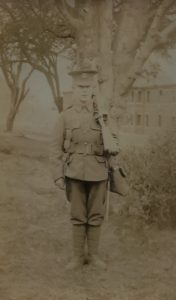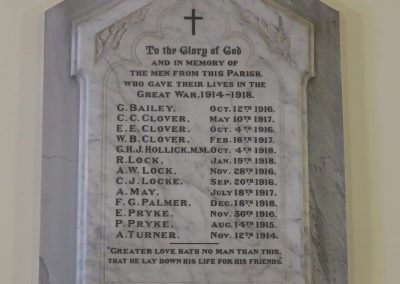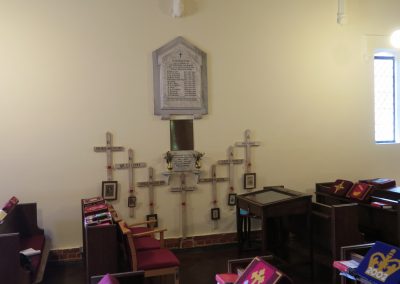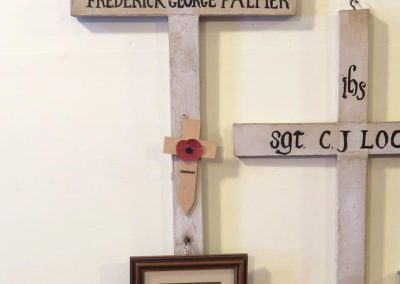Location: St Matthew’s Church, Leavenheath, Suffolk, CO6 4PT.
Leavenheath is curious. Seven crosses, one of which commemorates someone who died in a U-boat attack off Gallipoli who was unlikely to have had a cross being lost at sea. They are uniform in appearance and have been covered in what appears to be paper and paint with painted lettering all by the same hand. There is a story here, but it’s difficult to ascertain what exactly as it is impossible to see what is under the covering, and if they are in fact genuine crosses from the front or if they are facsimiles. It is possible that the paper and paint is dressing, but somehow they don’t seem to ‘Battlefield markers’.
The opinion here amongst the surveyors and the team is that these were possibly made post war as a War Memorial of sorts, possibly before the local war memorial was commissioned. Interestingly they don’t commemorate everybody on the memorial; we have to assume that the families of the men commemorated on these have a strong casual link to the Church. The case appears to be that these are probably copies or constructs, or actually don’t apply to the specific men. They may of course have been created later still. Whatever the story is, it is clear that they were made by a community to remember the men and still do furnish that desire for commemoration.
We are very open to anyone who has any further information on these crosses.
Surveys and photographs by Andrew Macdonald and Jason Kercher.
George Hollick
Details on cross:
IHS
at top of shaft
George Hollick MM
on cross beam.
RBL cross and poppy on lower shaft with framed photo
Text type (e.g. hand-written, GRU tags, carved): Hand painted in black on off white background. There is no sign of any GRU tags ever having been attached to this cross.
Cross dimensions (millimetres please)
Shaft Height: 970
Cross beam width: 400
Width of wood: 54
Thickness or depth: 25
Other information
Mounting to wall: Hook in head of shaft to hook in the wall
Detailing: None
Evidence of use in field (earth marking, cracking, staining, shrinkage): None
Surface insertion depth (into ground if apparent): N/A
Finish (varnish, paint, oiled, unfinished etc): Paint and paper
Condition (cracked, paint peeling, woodwork, damage etc): Fair. Some sign of woodworm
Other information, notes and observations: This is one of seven similar crosses in the church arranged below the war memorial and Roll of Honour. In all cases the cross beam has been covered in paper before painting. Private George H J Hollick 3rd Bn, Royal Fusiliers, was killed on October 4th 1918 and is buried at Guizancourt Farm Cemetery near St Quentin in northern France. A Military Medal is not recorded on his medal index card and I’ve not so far found a record in the London Gazette. Investigations continue.
Arthur (Billy) Locke
Details on cross:
IHS
at top of shaft
Arthur (Billy) Locke
on cross beam.
RBL cross and poppy on lower shaft.
Text type (e.g. hand-written, GRU tags, carved): Hand painted in black on off white background. There is no sign of any GRU tags ever having been attached to this cross.
Cross dimensions (millimetres please)
Shaft Height: 970
Cross beam width:400
Width of wood: 54
Thickness or depth: 25
Other information
Mounting to wall: Hook in head of shaft to hook in the wall
Detailing: None
Evidence of use in field (earth marking, cracking, staining, shrinkage): None
Surface insertion depth (into ground if apparent): N/A
Finish (varnish, paint, oiled, unfinished etc): Paint and paper
Condition (cracked, paint peeling, woodwork, damage etc): Fair, paint chipped, slight woodworm.
Other information, notes and observations:
This is one of seven similar crosses in the church arranged below the war memorial and Roll of Honour. In all cases the cross beam has been covered in paper before painting.
Private Arthur Willaim Lock or Locke, 9th Bn Suffolk Regiment was killed on 28th November 1916 aged 24. He is buried at Chocques Military Cemetery in northern France.
There is no evidence so far that the Locks or Lockes commemorated on the crosses were brothers.
 Charles John Lock (Locke)
Charles John Lock (Locke)
Details on cross:
IHS
at top of shaft
Sgt CJ Locke RBL
on crossbeam
cross and poppy on lower shaft with framed photo
Text type (e.g. hand-written, GRU tags, carved): Hand painted in black on off white background. There is no sign of any GRU tags ever having been attached to this cross.
Cross dimensions (millimetres please)
Shaft Height: 970
Cross beam width:440
Width of wood: 54
Thickness or depth: Shaft 25, cross beam 10
Other information
Mounting to wall: Hook in head of shaft to hook in the wall
Detailing: None
Evidence of use in field (earth marking, cracking, staining, shrinkage): None
Surface insertion depth (into ground if apparent): N/A
Finish (varnish, paint, oiled, unfinished etc): Paint and paper
Condition (cracked, paint peeling, woodwork, damage etc): Fair.
Other information, notes and observations:
This is one of seven similar crosses in the church arranged below the war memorial and Roll of Honour. In all cases the cross beam has been covered in paper before painting. Sgt Charles John Lock or Locke died of wounds on September 20th 1916 aged 21 and is buried at the Abbeville Communal Cemetery Extension in northern France.
 Robert Lock (Locke)
Robert Lock (Locke)
Details on cross:
IHS
at top of shaft
Pte Robert Locke
on cross beam.
RBL cross and poppy on lower shaft with framed photo.
Text type (e.g. hand-written, GRU tags, carved): Hand painted in black on off white background. There is no sign of any GRU tags ever having been attached to this cross.
Cross dimensions (millimetres please)
Shaft Height: 970
Cross beam width:450
Width of wood: Shaft 50
Cross beam 45
Thickness or depth: 25
Other information
Mounting to wall: Hook in head of shaft to hook in the wall
Detailing: None
Evidence of use in field (earth marking, cracking, staining, shrinkage): None
Surface insertion depth (into ground if apparent): N/A
Finish (varnish, paint, oiled, unfinished etc): Paint and paper
Condition (cracked, paint peeling, woodwork, damage etc): Fair, slight woodworm and pinholes..
Other information, notes and observations:
This is one of seven similar crosses in the church arranged below the war memorial and Roll of Honour. In all cases the cross beam has been covered in paper before painting.
Private Robert Lock or Locke, 8th Bn Suffolk Regiment and 53rd Bn Machine Gun Corps was killed on 19th January 1918 aged 25. He is buried at Artillery Wood Cemetery, Boezinge, Belgium.
There is no evidence so far that the Locks or Lockes commemorated on the crosses were brothers.
Edgar King Pryke
Details on cross:
IHS
at top of shaft
Lieut. E Pryke RFC
on cross beam.
RBL cross and poppy on lower shaft with framed photo
Text type (e.g. hand-written, GRU tags, carved): Hand painted in black on off white background. There is no sign of any GRU tags ever having been attached to this cross.
Cross dimensions (millimetres please)
Shaft Height: 970
Cross beam width:400
Width of wood: 54
Thickness or depth: 25
Other information
Mounting to wall: Hook in head of shaft to hook in the wall
Detailing: None
Evidence of use in field (earth marking, cracking, staining, shrinkage): None
Surface insertion depth (into ground if apparent): N/A
Finish (varnish, paint, oiled, unfinished etc): Paint and paper
Condition (cracked, paint peeling, woodwork, damage etc): Fair, some sign of woodworm.
Other information, notes and observations:
This is one of seven similar crosses in the church arranged below the war memorial and Roll of Honour. In all cases the cross beam has been covered in paper before painting. 2nd Lt Edgar King Pryke, Percy Pryke’s older brother, was born in 1895 and died in a flying accident on November 30th 1917 (not 1916 as recorded on the war memorial). He is buried at Dernancourt Communal Cemetery Extension in Picardy in northern France. The Grave Registration Report indicates that a cross with GRU tags was erected for him but we don’t think this is it. His War medal and Victory medal were sent to his mother Eugenie, by then living in London in 1922.
 Percy Pryke
Percy Pryke
Details on Cross
IHS
at top of shaft,
PTE P PRYKE
on cross beam.
Framed photo and In Memoriam card attached to lower shaft.
An RBL wooden cross and poppy have been added later.
Text type (e.g. hand-written, GRU tags, carved): Hand painted in black on off white background. There is no sign of any GRU tags ever having been attached to this cross.
Cross dimensions (millimetres please)
Shaft Height: 950
Cross beam width: 390
Width of wood: 55
Thickness or depth: 25
Other information
Mounting to wall: Hook in head of shaft to hook in the wall
Detailing: None
Evidence of use in field (earth marking, cracking, staining, shrinkage): None
Surface insertion depth (into ground if apparent): N/A
Finish (varnish, paint, oiled, unfinished etc): Paint and paper
Condition (cracked, paint peeling, woodwork, damage etc): Fair, some sign of woodworm and some paint cracking.
Other information, notes and observations:
This is one of seven similar crosses in the church arranged below the war memorial and Roll of Honour. In all cases the cross beam has been covered in paper before painting. Percy Pryke was lost at sea when the troop ship Royal Edward was torpedoed by U41 off Kandeloussa on August 13th 1915 while in transit to Gallipoli. He was only just seventeen years old, possibly still only sixteen.. He is commemorated on the Helles Memorial in Turkey. It seems unlikely therefore that this cross is a temporary grave marker returned to this country after the war, but rather a memorial made locally after the war.
 Fred Palmer
Fred Palmer
Details on cross:
IHS
at top of shaft
Frederick George Palmer
on cross beam.
RBL cross and poppy on lower shaft with framed photo.
Text type (e.g. hand-written, GRU tags, carved): Hand painted in black on off white background. There is no sign of any GRU tags ever having been attached to this cross.
Cross dimensions (millimetres please)
Shaft Height: 970
Cross beam width:450
Width of wood: 54
Thickness or depth: 25
Other information
Mounting to wall: Hook in head of shaft to hook in the wall
Detailing: None
Evidence of use in field (earth marking, cracking, staining, shrinkage): None
Surface insertion depth (into ground if apparent): N/A
Finish (varnish, paint, oiled, unfinished etc): Paint and paper
Condition (cracked, paint peeling, woodwork, damage etc): Fair.
Other information, notes and observations:
This is one of seven similar crosses in the church arranged below the war memorial and Roll of Honour. In all cases the cross beam has been covered in paper before painting.
Private Fred Palmer first served in 1/1 Suffolk Yeomanry, mobilised to Gallipoli in early October 1915. He survived the Gallipoli campaign and later transferred to the Labour Corps as a Lance Corporal, possibly because of wounds received or disease contracted at Gallipoli. His record shows he died, cause unspecified, on December 17th 1918 in Egypt aged 27. He is buried at the Cairo War Memorial Cemetery.
There is no evidence so far that the Locks or Lockes commemorated on the crosses were brothers.
























The Lock(e)s and the Hollicks are related. Not brothers, but all cousins of various sorts. Arthur Lock’s Grandparents (who brought him up) were Thomas Lock and Mary Ann Hollick. It gets a bit confusing as the two families are quite intermingled but you are welcome to see my family tree if you like.
Dear Freya. There are Hollicks in Wiston and one of them (Thomas son of Arthur) is on Wiston memorial. He had a brother George and another called John. I have been trying to work out where your Leavenheath George is linked. He was also born in Wiston. We are organising in an event in November here in Nayland. I am working on a small exhibition that will include the names of all the young men and memorials in the Benefice of the five parishes, including Leavenheath. It would be very helpful if you could untangle the two Georges for us. If you happen to have a family photo that includes Thomas it would be good to use that too.
Hello Freya,
I have just found this web page, and as I am also looking into my Locke family tree I was wondering if we are connected. My family originated in Rendlesham, the parish of St Gregory’s Suffolk and the family appeared to divide from Suffolk to Dedham via my great grandfathers brother George Locke.
Best wishes,
Keith Locke.